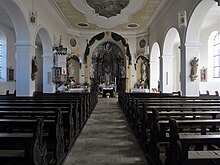St. Martin (Eltingshausen)
The Roman Catholic Church of St. Martin is the village church in the Lower Franconian Eltingshausen , a district of the Bavarian Bad Kissingen district located Oerlenbach .
The church is one of the architectural monuments in Oerlenbach and is registered under the number D-6-72-140-25 in the Bavarian monument list .
history
Today's St. Martin's Church was consecrated in 1745 and replaced a previous building, which was most likely built in the 14th century. An increase in the church tower is documented from this time. In the roof of today's church tower there are traces of a former chapel. Possibly the first church in town was made of wood; a church building made of stone was built in the 16th century at the latest. It is unclear whether the Lords of Eltingshausen - like many other aristocrats at that time - were buried in the church.
From 1744 to 1746 the nave of today's St. Martin's Church was built , the construction of which was necessary due to the increasing numbers of people and pilgrims in Eltingshausen. In addition, the half-timbered upper floor was added to the church tower and the pointed helmet erected. Since the cemetery was directly adjacent to the old church building, a new cemetery was created on today's Kissinger Strasse. In 1745, the St. Martin's Church was inaugurated by Prince Bishop Friedrich Karl von Schönborn-Buchheim . In 1824 the church tower received a belfry. A first renovation took place between 1909 and 1911; in 1913 a new sacristy and new church windows were installed. After three of the four bells had to be delivered due to the war in 1917 (the attempt by some villagers to hide them failed), a new bell was manufactured by a company in Heidingsfeld in 1920 and a company in Erfurt in 1923 . During the Second World War the big bell had to be delivered to the church. In 1947, after a year of preparation, the church began to expand. The nave was lengthened and side aisles were added. The topping-out ceremony took place on July 31, 1948; the consecration took place on November 11, 1949 by Bishop Julius Döpfner . The two remaining bells in the church were supplemented by two more bells in 1956. In 1963, an oil-fired warm air heating system was installed. In the years 1990/91 an exterior renovation of the nave and the church tower took place. An interior renovation of the church, which was previously painted in green, has not yet been carried out.
description
The church is an east-facing building with five window axes and ends with the church tower. This has a pointed helmet with a half-timbered upper floor. The nave with the attached aisles merges into the just closed choir. The sacristy is built on the south side of the choir.
Furnishing
This dates consistently from the time the nave was built. Mention should be made of the painting of the Nativity on the high altar and the ceiling painting of the Assumption of Mary , both by Johann Andreas Herrlein . The side altars of St. Sebastian and St. Maria are arranged to the right and left of the choir arch at the sloping corners of the nave. The organ is on the western gallery. Of the four bells, only three can currently be heard in the tone sequence g '- a' - c ”. The fourth bell, probably with the tone e ', is not rung because of the damaged half-timbered upper floor.
literature
- Manfred Herterich: Eltingshausen: From the history of a village , published by the municipality of Oerlenbach, 1985
- Georg Dehio : Handbuch der Deutschen Kunstdenkmäler: Handbuch der Deutschen Kunstdenkmäler, Bavaria I: Franconia: The administrative districts of Upper Franconia, Middle Franconia and Lower Franconia: BD I , Deutscher Kunstverlag Munich Berlin, 2nd, revised and supplemented edition, 1999, p. 321
- Manfred Herterich: The churches . In: Oerlenbach. Four become one , published by the municipality of Oerlenbach, 1997
Web links
Coordinates: 50 ° 9 ′ 28.6 ″ N , 10 ° 7 ′ 24 ″ E

